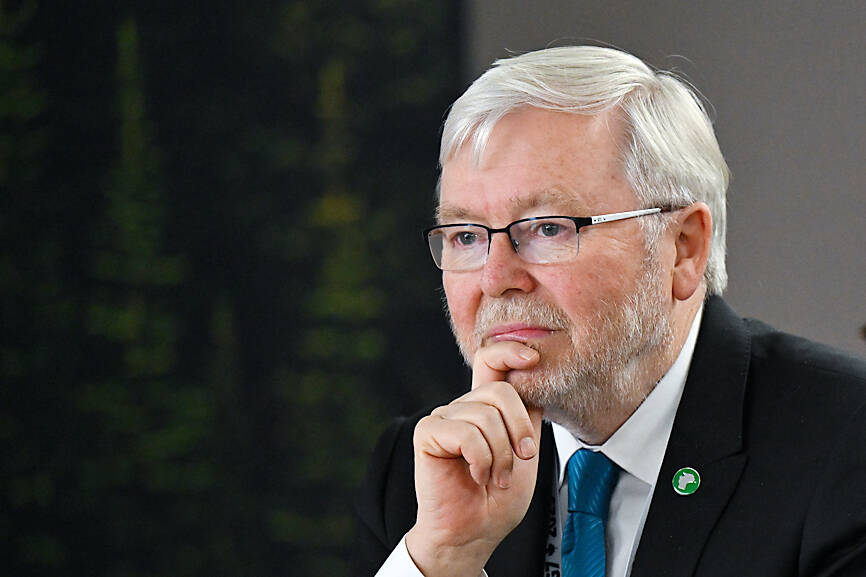Australian Ambassador to the US Kevin Rudd on Friday said that if Taiwan were to fall to China’s occupation, it would unleash China’s military capacities and capabilities more broadly.
He also said his country is working with the Pentagon on the US Department of Defense’s review of the AUKUS submarine project and is confident that all issues raised will be resolved.
Rudd, who served as Australian prime minister from 2007 to 2010 and for three months in 2013, made the remarks at the Aspen Security Forum in Colorado and stressed the longstanding US-Australia alliance and his close relationship with the US Undersecretary of Defense for Policy Elbridge Colby, who initiated the review.

Photo: EPA-EFE
“We’re working with Bridge and the team on the AUKUS review ... and we are confident that we’ll work our way through each and every one of the issues which he has raised in the context of this internal Defense Department review,” Rudd said, referring to Colby.
“Bridge has been around my place a lot of times, and so we have known each other for a long period of time, and that’s why I’m confident, quite apart from the mature relationship within our two defense establishments ... that we’ll work our way through this stuff,” he said.
The US-Australia alliance has endured through 15 presidents and 15 prime ministers from different parties, Rudd said.
In 2023, the US, Australia and the UK unveiled details of the AUKUS plan to provide Australia with nuclear-powered attack submarines from the early 2030s, part of efforts to counter China’s ambitions in the Indo-Pacific region.
It is Australia’s biggest ever defense project.
The Pentagon in June said it was reviewing AUKUS to ensure it was “aligned” with US President Donald Trump’s “America First” agenda, amid concerns about the ability of the US to meet its own submarine needs and whether Australia’s vessels would be used in support of US policy.
On Sunday last week, Australian Minister for Defence Industry Pat Conroy responded to a report that Colby had pressed Australia and Japan to clarify what role they would play if the US and China went to war over Taiwan by saying Australia would not commit troops in advance to any conflict.
Australian Prime Minister Anthony Albanese has also rebuffed US requests to commit to lifting defense spending from 2 percent to 3.5 percent of GDP, saying that Australia would spend what was needed for its defense.
The reported call by Colby on Australia to clarify its role regarding Taiwan raised eyebrows, given that Washington itself maintains a policy of “strategic ambiguity” and not directly saying how it would respond to any Chinese attack on Taiwan.
Rudd said Trump viewed unpredictability as one of his strengths as a leader, whereas China’s communist leadership craved predictability.
“Being unpredictable is no bad thing in terms of the way in which the Chinese view their strategic future on the critical question ... [of] the future of Taiwan,” he said.
Rudd added that Taiwan currently occupied Beijing’s entire military strategic focus, and if it were to fall, China’s “capacities and capabilities would be unleashed more broadly.”
“I believe that logic is galvanizing here in the United States as well as across allies,” he said.

The US government has signed defense cooperation agreements with Japan and the Philippines to boost the deterrence capabilities of countries in the first island chain, a report by the National Security Bureau (NSB) showed. The main countries on the first island chain include the two nations and Taiwan. The bureau is to present the report at a meeting of the legislature’s Foreign Affairs and National Defense Committee tomorrow. The US military has deployed Typhon missile systems to Japan’s Yamaguchi Prefecture and Zambales province in the Philippines during their joint military exercises. It has also installed NMESIS anti-ship systems in Japan’s Okinawa

‘WIN-WIN’: The Philippines, and central and eastern European countries are important potential drone cooperation partners, Minister of Foreign Affairs Lin Chia-lung said Minister of Foreign Affairs Lin Chia-lung (林佳龍) in an interview published yesterday confirmed that there are joint ventures between Taiwan and Poland in the drone industry. Lin made the remark in an exclusive interview with the Chinese-language Liberty Times (the Taipei Times’ sister paper). The government-backed Taiwan Excellence Drone International Business Opportunities Alliance and the Polish Chamber of Unmanned Systems on Wednesday last week signed a memorandum of understanding in Poland to develop a “non-China” supply chain for drones and work together on key technologies. Asked if Taiwan prioritized Poland among central and eastern European countries in drone collaboration, Lin

The Chien Feng IV (勁蜂, Mighty Hornet) loitering munition is on track to enter flight tests next month in connection with potential adoption by Taiwanese and US armed forces, a government source said yesterday. The kamikaze drone, which boasts a range of 1,000km, debuted at the Taipei Aerospace and Defense Technology Exhibition in September, the official said on condition of anonymity. The Chungshan Institute of Science and Technology and US-based Kratos Defense jointly developed the platform by leveraging the engine and airframe of the latter’s MQM-178 Firejet target drone, they said. The uncrewed aerial vehicle is designed to utilize an artificial intelligence computer

Renewed border fighting between Thailand and Cambodia showed no signs of abating yesterday, leaving hundreds of thousands of displaced people in both countries living in strained conditions as more flooded into temporary shelters. Reporters on the Thai side of the border heard sounds of outgoing, indirect fire yesterday. About 400,000 people have been evacuated from affected areas in Thailand and about 700 schools closed while fighting was ongoing in four border provinces, said Thai Rear Admiral Surasant Kongsiri, a spokesman for the military. Cambodia evacuated more than 127,000 villagers and closed hundreds of schools, the Thai Ministry of Defense said. Thailand’s military announced that